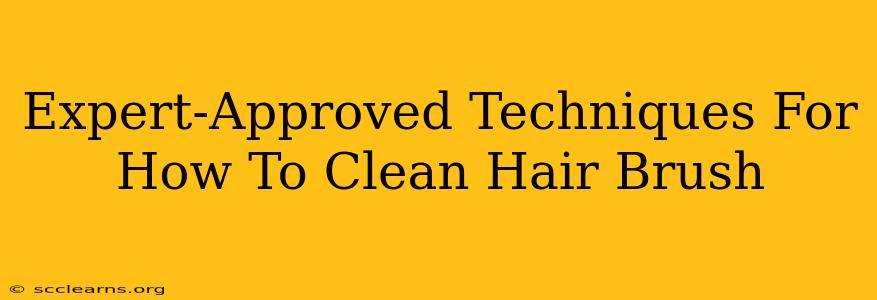Maintaining a clean hairbrush is crucial for healthy hair and scalp. A buildup of hair, dust, product residue, and oils can lead to clogged follicles, scalp irritation, and even contribute to hair breakage. This comprehensive guide provides expert-approved techniques to ensure your hairbrush remains hygienically clean and extends its lifespan.
Why Cleaning Your Hairbrush Matters
Before diving into the how, let's understand the why. A dirty hairbrush is a breeding ground for bacteria and fungi. This can lead to:
- Scalp irritation: Residue left on the brush can transfer back to your scalp, causing itching, inflammation, and even dandruff.
- Clogged hair follicles: Product buildup and dirt can block pores, hindering healthy hair growth.
- Spread of germs: Bacteria and fungi can easily transfer from your brush to your scalp and hair.
- Reduced brush effectiveness: A clogged brush can't effectively detangle or style your hair.
How to Clean Your Hair Brush: A Step-by-Step Guide
The cleaning method will depend on your brush type (paddle brush, round brush, vented brush, etc.), but the general principles remain the same. Here's a comprehensive approach:
1. Prepare Your Cleaning Station
Gather your supplies:
- Comb or tweezers: To remove large hair clumps.
- Warm, soapy water: Mild dish soap or a specialized brush cleaner works well.
- Towel: To dry your brush thoroughly.
- Optional: Disinfecting solution (like rubbing alcohol diluted with water).
2. Remove Loose Hair
This is the easiest step and should be done before every wash. Use a comb or your fingers to remove as much loose hair as possible from the brush bristles. For stubborn hair, tweezers can be helpful.
3. Deep Clean Your Hairbrush
This is where the cleaning magic happens. The approach varies depending on your brush type:
For Paddle Brushes and Similar Types:
- Soak: Submerge the brush head (avoiding the handle) in warm, soapy water for about 15-20 minutes.
- Scrub: Gently scrub the bristles with your fingers or an old toothbrush to loosen any remaining dirt and product buildup.
- Rinse: Rinse thoroughly under running water until all soap residue is removed.
For Round Brushes and Vented Brushes:
- Gentle approach: These brushes are more delicate. Use a small amount of soapy water and gently scrub the bristles with your fingers or a soft cloth.
- Avoid soaking: Soaking may damage the brush handle or loosen the bristles.
- Rinse and dry: Rinse thoroughly and pat dry with a towel.
Important Note: Always check the manufacturer’s care instructions for your specific brush.
4. Disinfect (Optional but Recommended)
After washing, you can further sanitize your brush by using a disinfecting solution. Mix rubbing alcohol with water (usually a 50/50 ratio) and gently wipe the bristles and handle. Allow to air dry completely.
5. Drying Your Hair Brush
Proper drying is crucial to prevent mold and mildew growth.
- Air dry: The best way is to lay the brush flat on a towel with the bristles facing downwards. Allow it to air dry completely.
- Avoid direct sunlight or heat: These can damage the brush bristles and handle.
6. How Often Should You Clean Your Hair Brush?
The frequency depends on your hair type and how often you use your brush. However, a good rule of thumb is to deep clean your hairbrush at least once a week. Removing loose hair daily is essential to maintain hygiene.
Maintaining Your Hairbrush for Longevity
- Regular cleaning: As mentioned above, consistent cleaning is key.
- Proper storage: Store your hairbrush in a dry, clean place.
- Replace when necessary: Over time, bristles wear down, and even with careful cleaning, your brush might lose its effectiveness. Replace your brush every 6-12 months, depending on usage.
By following these expert-approved techniques, you can ensure your hairbrush remains clean, hygienic, and effective, contributing to healthy, beautiful hair. Remember consistency is key for optimal results!

